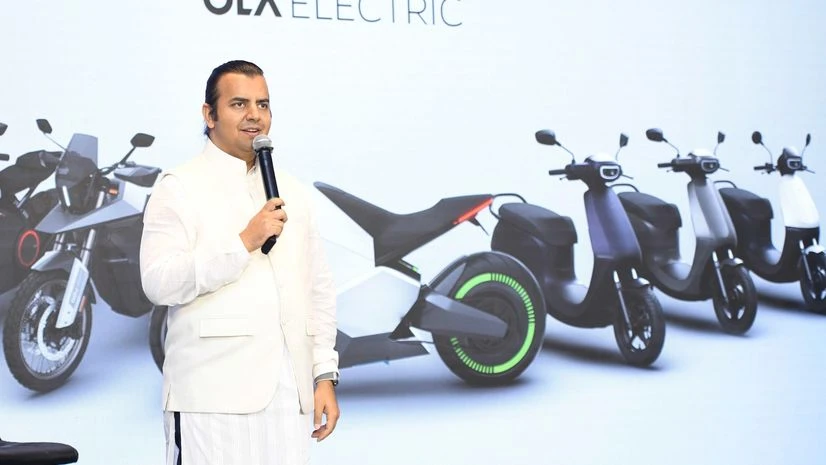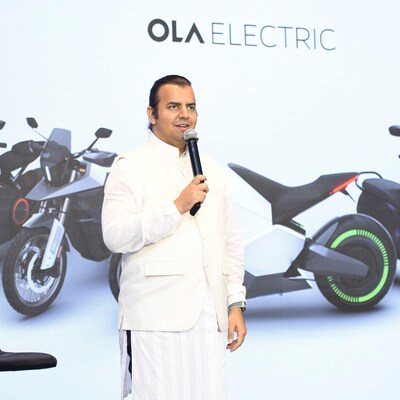)
Bhavish Aggarwal, CMD, Ola Electric Mobility Limited at the IPO Press Conference in Mumbai on Monday, 29th July 2024 | Photo: Kamlesh Pednekar
Ola Electric, a pioneer in India’s electric two-wheeler segment, is eyeing a valuation of $4 billion in its $734 mn initial public offering (IPO). Bhavish Aggarwal, founder and CEO of the loss-making firm, believes this IPO is a key step in the company’s long-term plans. Aggarwal, 38, shares his entrepreneurial journey and how the company is building scale in an interaction with Samie Modak, Sohini Das, and Shivani Shinde. Edited excerpts:
As an entrepreneur how big is the IPO milestone?
It’s a very important milestone in any entrepreneur’s journey; my own personal journey too. After coming to Mumbai as a college student, the dream was to create and build a successful business. Today that milestone is becoming a reality. For our group also, this IPO is important, as this is our first public listing. In future, we will have a few more. In this journey, we have engaged with the Street. Clearly, public investors have a very evolved view of this industry. We are looking forward to taking the Indian investor community along as we build the EV business for the future.
The offer for sale (OFS) component of the IPO is very small. Also, some investors are selling at a loss. Why so?
They clearly support us. They also invested when we raised funds through a private round late last year. Our private investors have been very supportive of our strategy in the past, as well as of the vision that we carry for this company.
Ola’s $4 billion valuation is much less than what was reported earlier. Have you scaled back the valuations?
I think the numbers that were reported were speculation; we never put out a number. Sometimes these speculations build on themselves. But then we had a choice and we chose to actually keep the IPO very attractively priced. For us, this is a long-term journey, and this company is just getting started. We want the entire investor community’s participation and support behind this company.
What is the feedback that you’ve got at this price?
We interacted with many investors and there’s been a lot of interest. I can’t share specific details. The overall feedback has been very positive on our story and our progress as a company.
After the listing, the promoter holding in the company will drop to 37 per cent. Do you see it falling further or have you put a hard stop?
This is primarily a fresh issue. More than 90 per cent is primary, and the secondary is spread across several investors. We wanted to make sure most of the money comes into the company. I have also cut back on my share in OFS. It shows where I feel the future is.
While Ola Electric has been a pioneer in the electric two-wheeler space, others are catching up fast. How do you see competition heating up in the sub-Rs 1 lakh space?
In Q1FY25, our overall market share was 47 per cent. It is good to see that everybody is coming to the EV party. Finally, they see the light, which I’ve been talking about for three years. But to play the game well, one needs the whole technology and manufacturing ecosystem, which we have created. And it is visible in our financials, product velocity, and in our scale. We will continue to double down on that.
What is the path to profitability and when can Ola Electric expect to achieve that?
I cannot share numbers or timelines by when we will be profitable. But if you see some of the numbers, you can see a trend. In FY24, revenue was up from FY23. Revenue was up 90 per cent, and gross margins were up 16 per cent from 7 per cent. Ebitda margins improved from a negative 43 per cent to negative 19 per cent in just one year. In addition, our volumes for Q1FY25 have also gone up. In the manufacturing industry, as you grow revenue, you get a lot of operational leverage because your fixed costs do not scale. Our next big step is Cell manufacturing. Cell is the heart of an EV in terms of cost. As we bring this to India and make it in-house, there will also be its impact.
Does Ola Electric have a global comparable player?
We are the only pure play two-wheeler EV of this scale. Of course, you have Tesla and BYD in the four-wheeler space.
If one looks at the related-party transaction, then Ola’s market share will go down?
It is not at all significant. Rather, it will be less than one-and-a-half per cent of overall sales. Also, it’s a different corporate entity, different board, and different everything.
First Published: Jul 29 2024 | 10:44 PM IST
